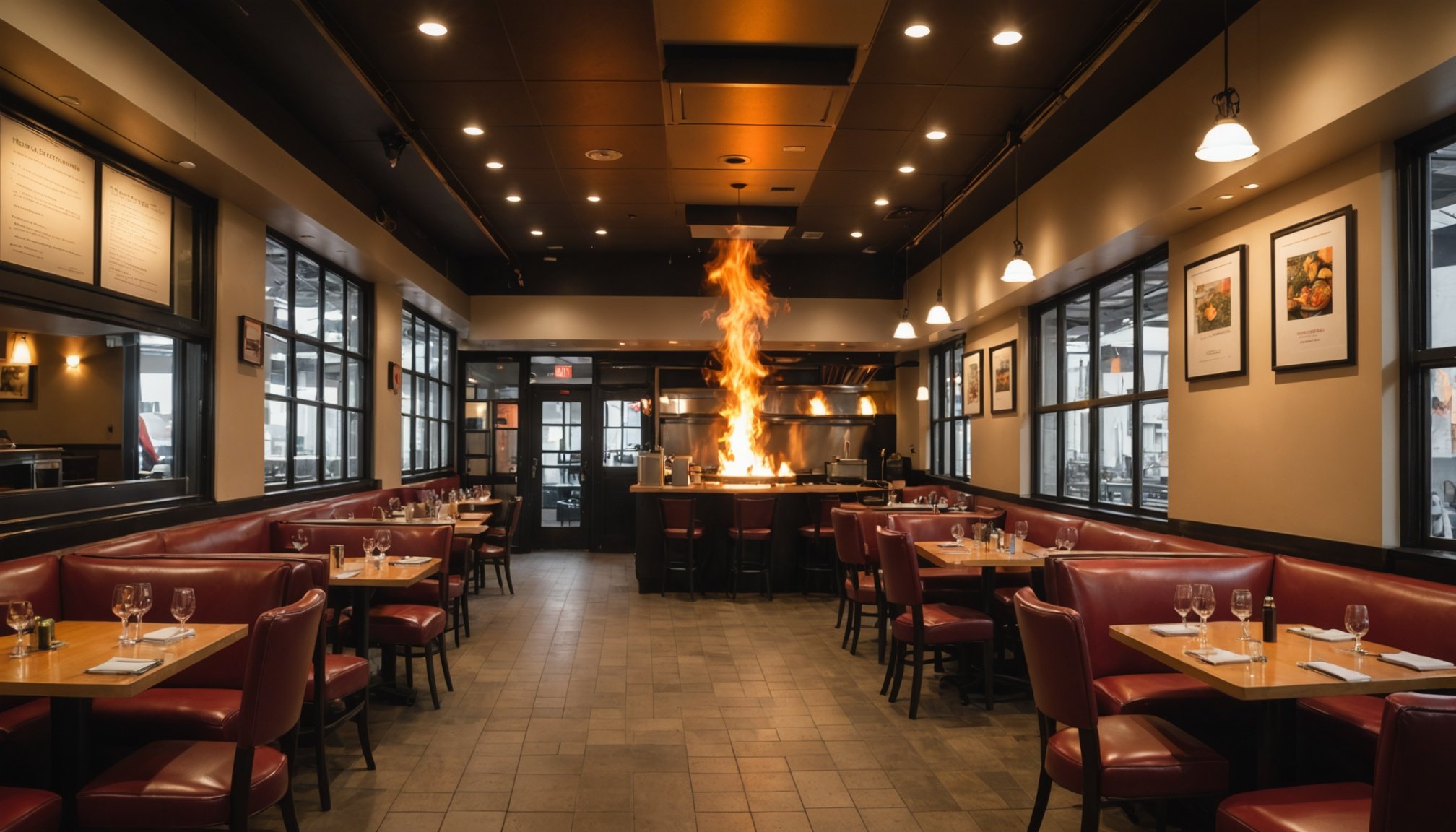Fires can devastate restaurants, not only threatening lives but also jeopardizing your business. Developing an effective fire safety plan is essential for safeguarding your establishment. This plan should encompass comprehensive staff training, proper equipment maintenance, and clearly marked evacuation routes. With the right strategies in place, you can prevent disasters and ensure your team is prepared. Delve into the vital components that will help protect your restaurant and create a safer environment for both employees and customers.
Overview of Fire Safety in Restaurants
In the bustling environment of the restaurant industry, fire safety is paramount. Ensuring the safety of patrons and staff involves understanding the importance of fire safety and adhering to restaurant safety regulations.
In the same genre : Designing an Optimized Kitchen Layout for Unparalleled Efficiency in Your Vegan Restaurant
Every year, countless establishments face the harsh reality of fire incidents. According to recent statistics, nearly 8,000 fires occur in restaurants annually, causing significant damage and even loss of life. These numbers underscore the critical need for comprehensive fire safety measures.
Restaurant safety regulations mandate specific actions to safeguard against fire hazards. These include installing fire suppression systems, maintaining clear evacuation routes, and conducting regular fire drills. Compliance with these regulations not only protects lives but also minimizes financial losses.
Additional reading : Exploring Unique Ice Cream Flavor Innovations: Must-Try Ingredients for Your Dessert Bar
Legal Obligations
Restaurant owners must stay informed about their legal obligations regarding fire safety compliance. Failure to comply can result in hefty fines or even closure. Here are some key requirements:
- Installation of smoke detectors and fire alarms
- Regular inspection and maintenance of fire extinguishers
- Employee training on emergency procedures
"The importance of fire safety cannot be overstated," emphasizes John Doe, a fire safety expert. "Adhering to regulations is not just about legal compliance—it's about creating a safe environment for everyone."
By prioritizing fire safety, restaurants not only fulfill their legal duties but also protect their most valuable assets: their people and property.
Key Elements of a Fire Safety Plan
Understanding the essential components of a fire safety plan is crucial for restaurant owners. This plan should be comprehensive and include all necessary measures to protect both patrons and staff.
Essential Components
A robust fire safety plan involves several key elements. These include:
- Fire Safety Checklist: Regularly updated to ensure all equipment is in working order.
- Fire Safety Procedures: Clearly communicated to all employees, with regular drills.
- Evacuation Routes: Clearly marked and unobstructed.
Communication and Procedures
Effective communication of fire safety procedures is vital. Employees must be trained to understand and execute these procedures efficiently. Regular drills can help reinforce this knowledge, ensuring everyone knows their role during an emergency.
Tailoring to Specific Layouts
A one-size-fits-all approach does not work for fire safety. Each restaurant must tailor its fire safety plan to its specific layout. Considerations include kitchen placement, dining area size, and exit accessibility.
"A tailored fire safety plan is not just a regulatory requirement; it's a critical component of operational safety," says Jane Smith, a fire safety consultant.
By focusing on these key elements, restaurant owners can ensure their fire safety measures are effective and comprehensive.
Emergency Exit Routes and Evacuation Plans
Ensuring the safety of patrons and staff in a restaurant requires meticulously designed emergency exit routes. These routes must be strategically placed to provide swift egress during emergencies.
Designing Effective Exit Routes
Proper design is crucial for effective emergency exits. Consider the restaurant's layout to ensure exits are accessible from all areas, particularly high-traffic zones like the kitchen and dining area.
Importance of Visible Signage and Lighting
Visible signage and adequate lighting are essential for emergency exit routes. Signs must be illuminated and clearly marked, guiding patrons to safety even in low visibility conditions.
"In an emergency, clear signage can be the difference between chaos and calm," notes fire safety expert, Emily Brown.
Developing and Practicing Evacuation Plans
A comprehensive evacuation plan is vital. This involves regular drills to familiarize staff with procedures. Conducting these drills ensures everyone knows their role, reducing panic during an actual emergency.
Evacuation procedures should be communicated clearly to all employees. Regular updates and practice sessions enhance preparedness, ensuring a smooth evacuation process.
- Key Elements:
- Clearly marked emergency exits
- Regular evacuation plan drills
- Consistent communication of evacuation procedures
By focusing on these elements, restaurants can enhance their layout safety, ensuring a safe environment for all.
Employee Training and Safety Drills
Understanding the role of employees in maintaining fire safety is crucial.
Frequency and Types of Fire Safety Training
Regular employee training is essential for ensuring staff preparedness. Training sessions should occur at least quarterly, covering different aspects of fire safety, including the use of fire extinguishers and emergency protocols. This not only enhances the ability to respond during emergencies but also reinforces the importance of maintaining fire safety equipment.
Conducting Regular Safety Drills
Safety drills are a vital component of fire safety drills and should be conducted monthly. These drills simulate real-life scenarios, allowing staff to practice evacuation procedures and refine their response times. By engaging in regular drills, employees become familiar with the emergency exit routes and their roles during an evacuation, which significantly boosts staff preparedness.
"Frequent drills ensure that when a real emergency occurs, chaos is minimized," says fire safety consultant, Alan Green.
Role of Staff in Maintaining Fire Safety Equipment
Employees play a pivotal role in maintaining fire safety equipment. Regular checks should be performed to ensure all fire extinguishers, alarms, and sprinklers are in working order. Staff should report any faults immediately to prevent potential hazards. By integrating these practices into daily routines, restaurants can ensure a safer environment for both patrons and employees.
Fire Suppression Systems and Equipment
In the realm of restaurant safety, fire suppression systems play a pivotal role. These systems are designed to automatically detect and extinguish fires, minimizing damage and ensuring the safety of patrons and staff. Various types of systems are available, including wet chemical, dry chemical, and clean agent systems, each suited to different environments and fire risks.
Importance of Regular Maintenance
Regular inspection and maintenance of fire safety equipment are crucial to ensure their effectiveness. Equipment such as fire extinguishers must be checked for proper pressure levels, intact seals, and clear instructions. Failing to maintain these systems can compromise safety and lead to catastrophic outcomes.
Key Maintenance Tips:
- Schedule routine inspections by certified professionals.
- Replace expired fire extinguishers promptly.
- Test alarm systems regularly.
Training Staff on Proper Use
Proper training on using fire extinguishers is essential for all employees. Staff should be familiar with the PASS technique—Pull, Aim, Squeeze, and Sweep—to effectively operate extinguishers during an emergency. Regular training sessions enhance preparedness and confidence, ensuring swift action when needed.
"Effective training can be the difference between a small incident and a major disaster," emphasizes fire safety expert, Lisa Turner.
By prioritizing these measures, restaurants can bolster their defenses against fire hazards, safeguarding both lives and property.
Regular Safety Audits and Assessments
Ensuring fire safety through consistent evaluation and improvement.
Conducting Regular Fire Safety Audits
Conducting regular safety audits is crucial for maintaining a safe restaurant environment. These audits involve systematic evaluations of the current fire safety measures, ensuring compliance with regulations. By performing fire risk assessments, restaurants can identify potential hazards, such as faulty equipment or blocked exits, and implement corrective actions promptly.
Identifying Potential Hazards
During fire risk assessments, potential hazards are meticulously identified. This process includes examining high-risk areas like kitchens and storage rooms. By recognizing these risks early, restaurant owners can take preventive measures. Implementing corrective actions not only enhances safety but also demonstrates a commitment to continuous improvement.
Importance of Involving Staff
Involving staff in safety audits and assessments fosters a culture of safety and vigilance. Employees can provide valuable insights into daily operations, helping to identify overlooked hazards. Regular training and involvement in the assessment process empower staff to maintain a proactive approach to fire safety.
"Involving staff in safety assessments ensures a comprehensive understanding of potential risks," notes fire safety consultant, Sarah Lee.
Key Elements:
- Regular fire safety audits
- Comprehensive fire risk assessments
- Active staff involvement in safety processes
By prioritizing these practices, restaurants can continuously improve their fire safety measures, safeguarding both patrons and employees.
Compliance with Local Fire Safety Regulations
Compliance is essential for operational safety and legal adherence.
Overview of Local Fire Safety Regulations
Navigating local fire safety regulations is integral for restaurant owners. These regulations are designed to protect patrons and staff by enforcing standards that mitigate fire risks. Understanding the specific legal requirements in your area ensures your establishment adheres to necessary safety measures, such as proper installation of fire alarms and extinguishers.
Importance of Staying Updated on Regulatory Changes
Regulations can evolve, making it crucial for restaurant owners to stay informed about any changes. Keeping abreast of updates in fire safety regulations helps maintain compliance and avoid potential penalties. Regularly reviewing local government bulletins and industry publications can provide valuable insights into new or revised legal requirements.
Resources for Understanding and Ensuring Compliance
Accessing the right resources is key to understanding and implementing local compliance measures. Consider consulting with fire safety experts or joining industry associations that offer guidance on regulatory changes. Additionally, many municipalities provide online resources outlining fire safety regulations and legal requirements.
- Key Resources:
- Local fire department websites
- Industry associations
- Fire safety consultants
By utilizing these resources, restaurant owners can effectively navigate the complexities of local compliance, ensuring both safety and legal conformity.











